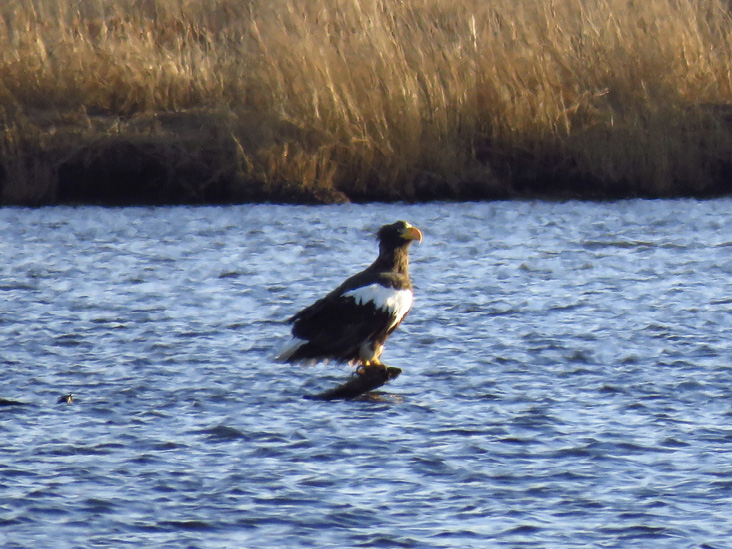Lisa Schibley and Marshall J. Iliff

Figure 1. Steller’s Sea-Eagle in the Taunton River, Dighton, Massachusetts, December 17, 2021. Photograph by David Ennis.
A Steller’s Sea-Eagle (Haliaeetus pelagicus), a bird of northeastern coastal Russia, Korea, and Japan, that wandered for 16 months around parts of North America—a continent on which it does not belong—was discovered in Dighton, Massachusetts, on December 12, 2021. It was seen again on December 17, but news only reached the birding community on December 19. Although it was missed in a search on December 19, it was refound by the Eckerson brothers on December 20 through shrewd and precision planning based on their knowledge of the Taunton River watershed.
In a normal year, the idea of someone photographing a Steller’s Sea-Eagle visiting the Taunton River in southeastern Massachusetts would be ludicrous—the only likely explanation being an escaped bird or an odd photoshop joke. Steller’s Sea-Eagles are one of the largest birds on the planet, with a wingspan of up to eight feet. They are one of the rarest eagles, with fewer than 5,000 individuals. There has never been a record in Canada or the lower 48 United States; even inland records in Alaska are exceedingly rare.
But this has not been a normal year. Over the past 16 months, sightings of an adult Steller’s Sea-Eagle have astonished the birding world. First, in August 2020, birder Josh Parks recorded an unusual interior record in Alaska; most sightings are coastal. Then on March 7, 2021, Kris and Jeff Groscop and Gene and Sandi Roesler were boating and fishing on Coleto Creek Reservoir in Victoria County, Texas. When they submitted pictures of a Steller’s Sea-Eagle on a tree stump in the middle of the reservoir, it seemed to defy belief. Despite extensive searching, the bird was never refound. Birders speculated that it could have been the Alaska eagle, but there were not enough photographs for an extensive comparison. More to the point: how could such a rare, large, and distinctive eagle have flown 3,200 miles over two countries full of birders and photographers without being observed? The mystery quieted down until June 2021, when a Steller’s Sea-Eagle appeared in New Brunswick, Canada, photographed first by Andrew Olive. Over the next two months, the Steller’s Sea-Eagle flew from Chaleur Bay, New Brunswick, to Gaspé and Matane, Quebec. It disappeared for three months and reappeared in Falmouth, Nova Scotia, 300 miles away, where, after two days of sightings in early November, it vanished again.
Until Dighton, Massachusetts, where David Ennis photographed the adult Steller’s Sea-Eagle on December 12. He eventually passed the photo to the Massachusetts Division of Fisheries and Wildlife (MassWildlife), knowing it was unusual, but perhaps not knowing exactly how unusual it was.
To view the rest of the article you'll need to
subscribe. Bird Observer publishes original articles on birding locations, on avian populations and natural history, on regional rarities, field notes, field records, photographs, and art work.